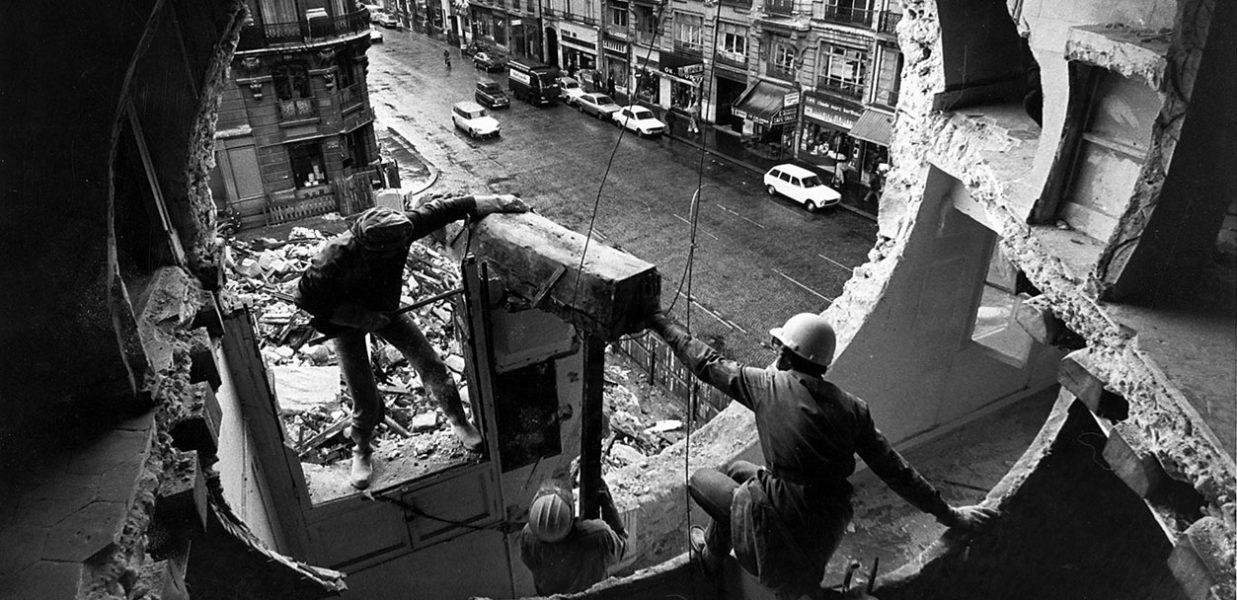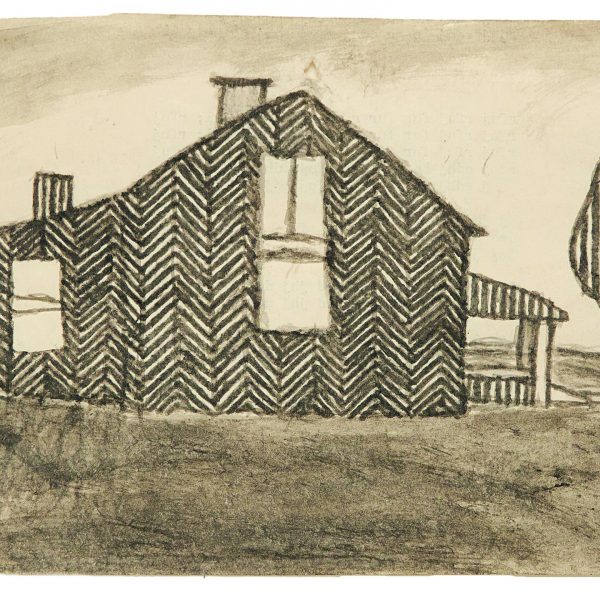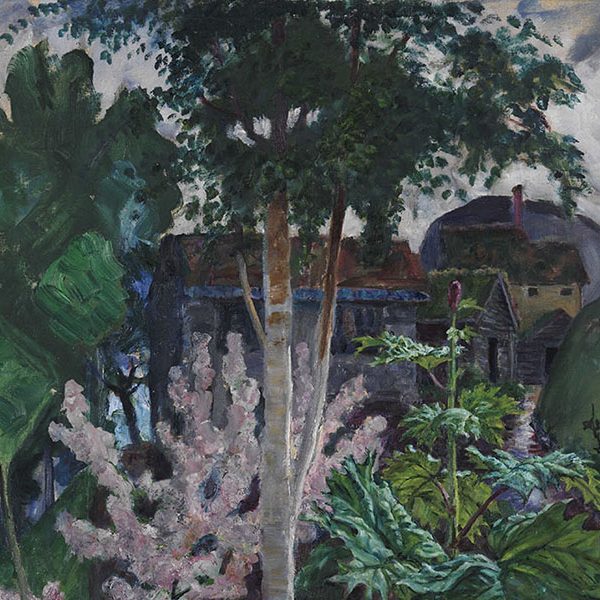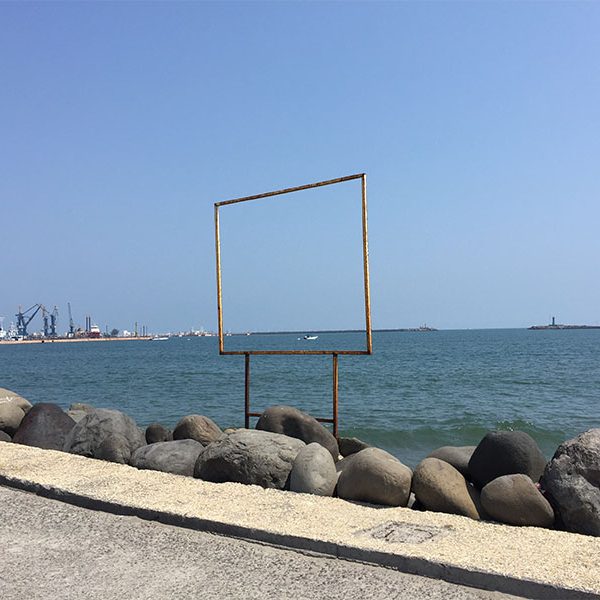Illuminating the Void: Gordon Matta-Clark’s Urban Interventions
Interview with Bronx Museum curator Antonio Sergio Bessa
By David Ebony
In recent years, I have been periodically spending time away from the city, in a rural area in upstate New York. It’s a pleasure to be closer to nature after many years as a city dweller. Gardening is a rewarding experience. A bucolic drama starring trees and other vegetation unfolds every day, all of its own accord. Rolling hillsides with their infinite perspectives have a calming effect conducive to certain kinds of activities—reading, planning, and research, for instance, or just clear thinking. Surprisingly for me, however, it is not necessarily an ideal environment for writing.
Easier access to art and culture in the city is a factor in the kind of writing I do, certainly, but also the inevitable proximity of people, of society, for better or worse—potential readers some day, perhaps?—all provide serious daily motivation. In addition, the anxiety and stress generated by the city, grating as it may be, can act as a catalyst for a text. The late Duncan Smith, a dear friend and colleague who wrote for Artforum and other publications, often said—only half jokingly—“Anxiety is the spice of life.” He recognized its potential as a positive, creative force, fundamentally urban-based.
Even more surprising is the renewed appreciation I found for the urban landscape—for the intensity of the built environment and the ceaseless audio-visual cacophony of new construction that is now symptomatic of New York City living, and that once seemed so abhorrent. An old tenement building across the street from my Williamsburg apartment was recently deconstructed and transformed into a massive, glitzy and somewhat frightening multi-story structure for luxury condos, a transformation that happened seemingly overnight. That sort of architectural transmogrification is rife these days. Most often motivated by real estate greed, surely, these developments harbor woeful socio-economic implications. Therefore, a careful and imaginative study of the conditions of urban architectural metamorphosis would be useful and pragmatic. For that reason alone, the work of Gordon Matta-Clark appears ever more prescient and increasingly significant.
An artist who trained as an architect, Matta-Clark (1943-1978) was the son of the renowned Surrealist painter Roberto Matta, and the artist Anne Clark, whose last name he adopted. The godson of Marcel Duchamp’s wife, Teeny, he had a twin brother, Sebastian, also an artist, who committed suicide in 1976. Gordon produced an exceptionally profound and influential body of work during his brief career in the late 1960s through the early ’70s. Before he succumbed to cancer at age 35, he demonstrated a new way of working within the urban landscape, and embodied a novel approach to architecture as well as social structures. He was a visionary architect without buildings, yet his vision remains with us—realized in films, photographs, sculptural objects and texts. Idealistic and daring, his work nearly always encompasses a performative element. He advocated collaborative, community endeavors to improve the aging urban infrastructure, and helped redefine the role of the artist in the process. Often heralded as a pioneer of Conceptual art, Earth Art, or Minimalism, his work does not fit comfortably into any of those categories.
His formidable achievement is explored in a compelling exhibition and accompanying publication, Gordon Matta-Clark: Anarchitect. The show was co-organized by Bronx Museum curatorial director Antonio Sergio Bessa, and Jessamyn Fiore, independent curator and co-director of the Gordon Matta-Clark estate. While not a full-scale survey of the artist’s work, the exhibition as well as the book aim for an in-depth exploration of several of the artist’s key urban projects, and especially the special relationship he had with the South Bronx. Featuring over one hundred works, the show remains on view in the Bronx through April 8, before an extensive tour. It appears at the Jeu de Paume, Paris (June 4-September 23), and travels to the Kumu Art Museum, Tallinn, Estonia (March 1-August 4, 2019), and to The Rose Art Museum, Brandeis University, Waltham, Massachusetts (September 12-December 15, 2019). The exhibition was the last at the museum to be presented during the tenure of its late director Holly Block (1958-2017), a longtime friend and colleague of mine. This article and interview are dedicated to her memory.
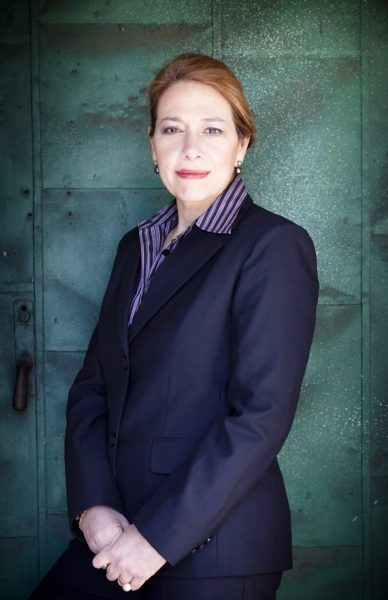
Holly Block; Photo: Peter Serling
The show’s title Anarchitect suggests an “anti-architect,” one engaged in an “anarchitecture,” a term ostensibly used by at least one writer critical of Le Corbusier’s questionable urban planning schemes. In relationship to Matta-Clark’s work, the term implies an anarchic position, a deconstructive process counter to any conventional building or design. Well-known for cutting holes in derelict homes, apartment houses, and office buildings, Matta-Clark intended to dismantle, and literally upend the kind of dehumanized modernist architecture that epitomizes the twentieth-century urban condition. In a recent telephone conversation, I spoke with Sergio Bessa about the exhibition, and the meaning and significance of Gordon Matta-Clark’s work today.
David Ebony To start, could you give a general introduction to Gordon Matta-Clark’s work, and why you think it remains relevant and important?
Sergio Bessa Gordon produced his work during a very pivotal era for New York, and for the entire country as well. There were big changes underway; as you know, there was a huge economic crisis in the early and mid 1970s. Gordon begins his work in the late ’60s, using the language of architecture. But the most important phase really begins in 1972, with his Bronx Floors pieces [cutting into floors and walls in derelict buildings of the South Bronx]. He was most active in the moment when New York City was at a breaking point. His attitude toward the role of the artist is exemplary today because he was not simply interested in aesthetics. He also knew the weight of the time, and he addressed that in everything he did. Very few artists were able to do that.
One thing I was always uncomfortable with when reading about his work from other writers and curators, was that they try to situate him within the art-historical continuum, the progression leading through modernism to Minimalism. I don’t think he cared at all about that. In a sense he was a very pragmatic person. He was trained as an architect; and toward the end of his training he meets Robert Smithson at Cornell in 1969—at time of Earth Art exhibition there [at the Herbert F. Johnson Museum of Art]. Gordon is taken with the visionary approach that Smithson and some of the others had. He didn’t really embrace the “Earth Art” label, or maybe he did a little bit, since he helped Smithson and others with their work. But he went on to do something unique, based on his training as an architect, and his knowledge of architecture. His endeavor was also complicated by his relationship with his father, the artist Roberto Matta, who was also trained as an architect, and had worked with Le Corbusier. As a young man, coming out of Cornell with his degree, he came to New York and saw that everything was falling apart there.
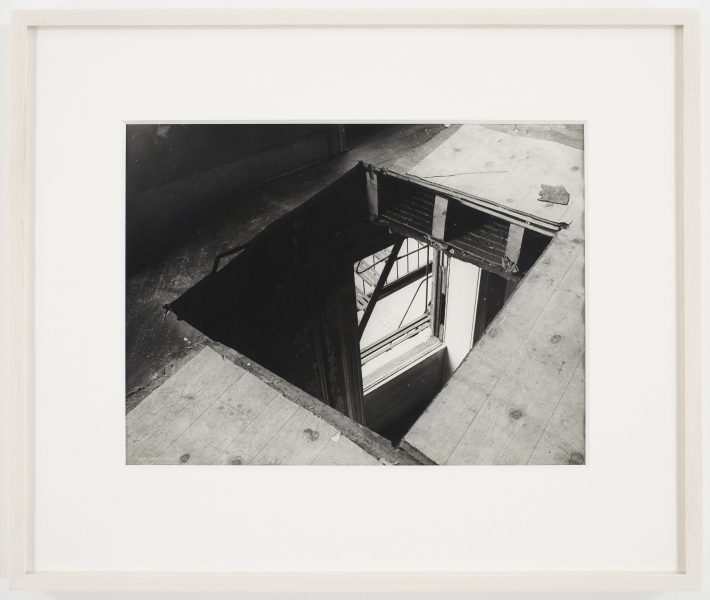
Gordon Matta-Clark, Bronx Floors, 1973; Gelatin silver prints; Each: 11 x 13 7/8 inches (27.9 x 35.2 cm)
Ebony In your essay, you begin by discussing the Vietnam War protests; you situate Matta-Clark in the context of those protests, and cite specific incidents like the bombing of the Weather Underground building in New York. Could you say more about that context?
Bessa Recently, someone asked me how Matta-Clark avoided going to Vietnam, since the military draft went on into the mid 1970s. I don’t know the answer to that but in reading his interviews and his writings, it’s clear that he was definitely a young man of that moment, concerned with the role of the United States, not only in Vietnam, but in the Cold War, etc. He was a very political person. In my essay, I try to conjure those kinds of anarchic outbursts in the city, like the Weathermen, and the student rebellions in Paris, and so forth. All of those incidents informed his practice because he was kind of an anarchist from the beginning. As I discuss in my essay, Gordon co-opted the kind of language of anarchy, defined by the Communards in the 19th century.
Ebony This leads me to the question of “anarchitecture,” how you define that, and how you chose Anarchitect as the title for this particular exhibition and book.
Bessa It was a decision my co-curator Jessamyn Fiore and I came to. I was always intrigued by Anarchitecture, the 1974 exhibition that Gordon organized [for 112 Greene Street, an experimental exhibition space in New York’s SoHo]. Since that was a group exhibition, Jessamyn suggested using just “Anarchitect,” as the title for our exhibition, as it refers specifically to Matta-Clark. I realize, though, that the word “anarchitecture” was initially probably a joke about Le Corbusier that was circulating in the late 1960s and early ’70s. It was basically about how Le Corbusier’s vision for modern architecture and urban planning was failing everyone, and particularly in the United States, in cities such as St. Louis, with its misguided housing projects of the 1950s and ’60s. In my essay, I mention this idea of social engineering through architecture that was basically a failure. I think Gordon was keenly aware of that, and addressed it in his work.
Ebony You include examples of real entropy that surrounded Matta-Clark, like the collapse of the Mercer Arts Center building in New York.
Bessa Yes, it was all around him, but also very connected to what he was doing. I found a note by Gordon saying that his only known cousin died in that freaky accident, so it was not just a story of a collapsing wall, but a tragedy that was personally very close to him. The reason I mentioned the explosion in the West Village house was because it was just a block away from the building where he grew up. So I wanted to paint a picture of someone creating his art in the midst of all of this urban decay, which is really fascinating.
Ebony I was struck by Jessamyn Fiore’s comments in your interview with her in the book, where she mentions that “To value non-use, to embrace an anarchy of form and function that he views as intrinsically American. . . ” and that in his writing, Gordon refers to “the pregnant void. Made visible because of the edge. This I always hold on to,” she says, “his practice as the illumination of the full void.” I was thinking of those comments especially in relationship to Conical Intersect (1975), the incredible work in Paris, where he created a “void”—he and a few collaborators carved out an enormous hole or portal into a soon-to-be-demolished apartment building. The fantastic video of that event is featured in the exhibition.
Bessa There was a shift in his practice from the time of the Bronx Floors (1973) and Conical Intersect. He comes to the Bronx and he cuts pieces from the buildings. What he cuts becomes the artwork—a physical art object. In Days End [a 1975 New York City project on pier 52], and Conical Intersect, the pieces that he cuts become discarded; what becomes the artwork is the void. It’s a very interesting kind of play there.
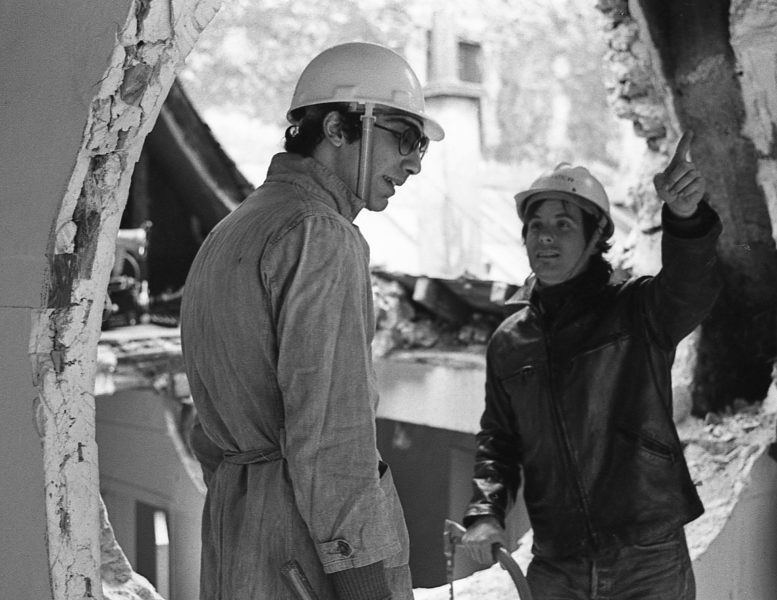
Gordon Matta-Clark and Gerry Hovagimyan working on Conical Intersect, 1975; Photo: Harry Gruyaert
© 2017 Estate of Gordon Matta-Clark / Artists Rights Society (ARS), New York and David Zwirner, New York.
Ebony Could you briefly discuss the relationship Gordon had with the Bronx? It seems most appropriate for the show to debut at the Bronx Museum.
Bessa The show has a special significance for the community. It is also personally very meaningful to me. I went to architecture school, and later went on to do other things. Gordon Matta-Clark has always been a figure of great interest to me. He produces a kind of critique of architecture. Anyone who ever went to architecture school will feel a kinship with him. The Bronx Museum was inaugurated in 1971, the very same period that is the focus of our show. I have been working here for fifteen years. I was amazed at first that community activists in the Bronx would think that a museum and culture could bring the community together, and it was done in such a successful way. The goals were very utopian, very idealistic, quite like Gordon’s. He begins to come to the Bronx regularly in 1972, so I thought there was a chronological intersection here, an overlap, and a kind of synchronicity that I wanted to explore.
Gordon presented this idea that you do not shy away from destruction and from hard times. That is the central message in a lot of his works. How can you extract beauty from all of that devastation? Of course, his example is so pertinent right now due to the situation that great cities across the U.S. are facing—the same situation that New York City dealt with in the mid-1970s.
Ebony There is considerable emphasis on Matta-Clark’s photography in the show—particularly images of graffiti-covered walls in the South Bronx, from 1973, many of which are hand-painted, or hand-tinted.
Bessa We felt that it was important to highlight the graffiti photographs. Both the graffiti photos and the more famous Bronx Floors images were done at the same time. So I was amazed to discover that over the years curators of other Gordon Matta-Clark exhibitions totally overlooked that body of work. I thought that we should show everything we could. All of them are black-and-white photographs, but some are airbrushed with color. I wanted to add more and more of them to the show. Some of my colleagues were concerned that they were too repetitious; but I thought that the minor differences in detail from one photo to another were really fascinating. It makes you look more closely. As a curator, I felt strongly that there is much to be discovered in the nuances. The fact that he hand-printed them is meaningful. He was an excellent photographer—he knew the craft very well—and these photos are gorgeous.
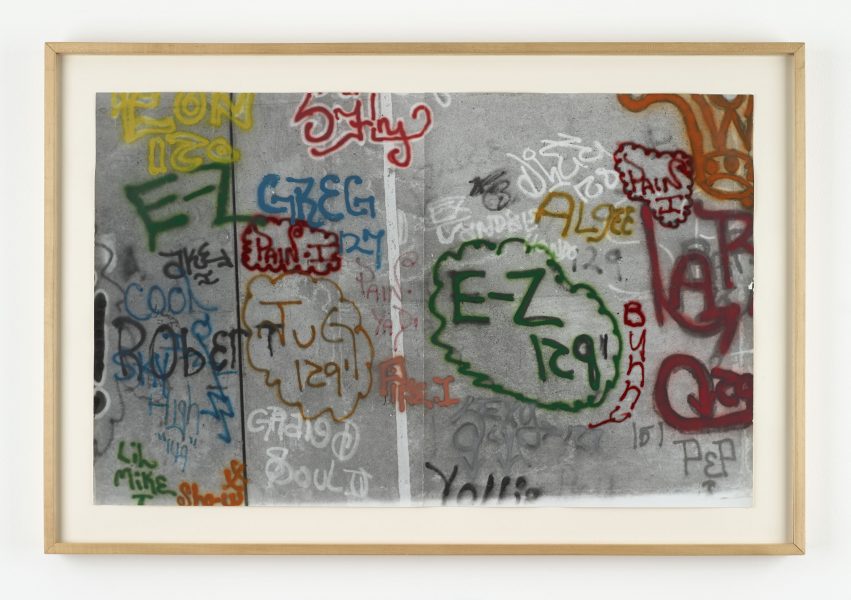
Gordon Matta-Clark, Graffiti: E-Z 129, 1973. Gelatin silver print with hand coloring © The Estate of Gordon Matta-Clark. Courtesy The Estate of Gordon Matta-Clark and David Zwirner, New York/London/Hong Kong
Ebony What would you say Matta-Clark’s legacy is, or will be? Why should young people pay attention to this work?
Bessa You know that he died young, in 1978, at age 35. It is amazing how much he achieved in that short time. He accomplished so much in terms of understanding the urban environment, and the realization of his own practice. I think of Gordon and his work as a kind of Chinese box, one of those nesting boxes, where you open one box and there’s another inside, and then another, and another. There is still a lot more of his work that needs to be fully assessed and defined. Our focus here was on the Bronx, the Bronx community, and the architecture; but there is much more to him that can be explored. He was a visionary architect. He left no buildings, but he proposed an architecture that is inclusive and would engage everyone in the creation of a social space.
Ebony In closing, would you say a few words about Holly Block, and what it was like to work with her? To me, she was a dear person, and very encouraging, and appreciative of my writing over the years.
Bessa Holly was fantastic. She gave me so many opportunities. She was very excited about this show. As you know, she was quite ill for over a year, during the time we worked on the project, but I would report to her frequently. She was a strong leader, and very opinionated; but once she cleared a project with me, she gave me full range of whatever I wanted or needed to do. She would ask the tough questions, of course—like how are you going to do this, or how will you fund that?—but in a way she was very hands off, and very supportive.
Sergio Bessa is the director of Curatorial and Educational Programs at the Bronx Museum. A concrete poetry scholar, he is the author of numerous essays and books on the subjects of art, architecture, and photography.
David Ebony is currently a Contributing Editor of Art in America magazine. Among his books are Arne Svenson: The Neighbors (2015); Anselm Reyle: Mystic Silver (2012); Carlo Maria Mariani in the 21st Century (2011); Emily Mason (2006); Botero: Abu Ghraib (2006); Craigie Horsfield: Relation (2005); and Graham Sutherland: A Retrospective (1998). He lives and works in New York City.
Further reading:
Gordon Matta-Clark: Anarchitect by Antonio Sergio Bessa and Jessamyn Fiore























